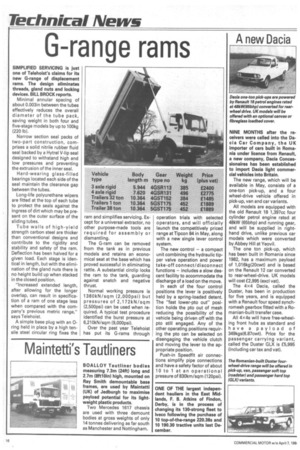6-range rams
Page 18

If you've noticed an error in this article please click here to report it so we can fix it.
SIMPLIFIED SERVICING is just one of Telehoist's claims for its new G-range of displacement rams. The design eliminates threads, gland nuts and locking devices. BILL BROCK reports.
Minimal annular spacing of about 0.003in between the tubes effectively reduces the overall diameter of the tube pack, saving weight in both four and five-stage models by up to 100kg (220 lb).
Narrow section seal packs of two-part construction, comprises a solid nitrile rubber fluid seal backed by a Hytrel V-lip seal designed to withstand high and low pressures and preventing the extrusion of the inner seal.
Hard-wearing glass-filled bearings located each side of the seal maintain the clearance gap between the tubes.
Long-life polyurethane wipers are fitted at the top of each tube to protect the seals against the ingress of dirt which may be present on the outer surface of the sliding tubes.
Tube walls of high-yield strength carbon steel are thicker than conventional designs and contribute to the rigidity and stability and safety of the ram. Deflection has been halved for a given load. Each stage is identical in length, but with the elimination of the gland nuts there is no height build up when stacked in the closed position.
"Increased extended length, after allowing for the longer overlap, can result in specification of a ram of one stage less when compared with the company's previous metric range," says Telehoist.
A simple base plug with an 0ring held in place by a high tensile steel circular ring fixes the
ram and simplifies servicing. Except for a universal extractor, no other purpose-made tools are required for assembly or dismantling.
The G-ram can be removed from the tank as in previous models and retains an economical seat at the base which has proved successful in eliminating rattle. A substantial circlip locks the ram to the tank, guarding against snatch and negative thrust.
Normal working pressure is 1380kN/sqm (2,000psi) but pressures of 2,17 2kN/sqm (2,500psi) can be used when required. A typical test procedure identified the burst pressure at 6,210kN/sqm (9,000psi).
Over the past year Telehoist has put its G-rams through operation trials with selected operators, and will officially launch the competitively priced range at Tipcon 84 in May, along with a new single lever control system.
The newcontrol — a compact unit combining the hydraulic tipper valve operation and power take-off connect/disconnect functions — includes a slow descent facility to accommodate the discharge of a load on the move.
In each of the four control positions the lever is positively held by a spring-loaded detent. The "fast lower-pto out" position holds the pto out of mesh reducing the possibility of the vehicle being driven off with the pto still engaged. Any of the other operating positions requiring the pto can be selected on disengaging the vehicle clutch and moving the lever to the appropriate position.
Push-in Speedfit air connections simplify pipe connections and have a safety factor of about 10 to 1 at an operational pressure of 830km/sqm (120psi).




































































































